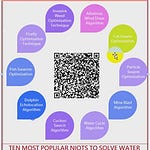Reservoir routing is a critical hydrological process used to analyze and predict how water flows through a reservoir over time. It involves balancing the inflow, outflow, and changes in storage within the reservoir to determine the outflow hydrograph. This process is essential for understanding the behavior of reservoirs during flood events, optimizing their operations, and ensuring the safety of downstream areas.
Key Components of Reservoir Routing:
Continuity Equation: The fundamental principle of reservoir routing is the conservation of mass, expressed as: [ \Delta S = I - O ] where ( \Delta S ) is the change in storage, ( I ) is the inflow, and ( O ) is the outflow.
Storage-Outflow Relationship: The relationship between the reservoir's storage and its outflow is crucial. It depends on the reservoir's geometry, spillway design, and outlet structures.
Time-Step Analysis: Reservoir routing is typically performed over discrete time intervals to calculate the changes in storage and outflow.
Applications:
Flood Management: Helps in designing reservoirs to mitigate flood risks by controlling peak flows and reducing downstream flooding.
Water Resource Optimization: Assists in managing reservoirs for irrigation, hydropower generation, and water supply.
Dam Safety: Evaluates the capacity of spillways and outlets to handle extreme inflow events, ensuring the structural integrity of dams.
Reservoir routing is a cornerstone of water resource engineering, enabling effective planning and management of reservoirs to balance ecological, economic, and safety considerations.
In this podcast, I have selected five reservoir routing methods based on their popularity, reliability, ease of use and data requirements. Our opinions may vary. But after viewing the podcast, please comment your opinion. Whether you agree with me, or do you have some other methods that you want to recommend?
This tutorial is a part of the E-Course on : Introduction to Flood Routing; Click here to access it.
Click here to upgrade and access the above content for more than seven days. Free members can access the content only for seven days after publication.
If you want to pay in INR then do so by clicking here
You may also like
To purchase 50 ideas for Starting a Business in US dollars: Click here
Simplify website creation with AI(AD)
Very Short-Term Course on Hydroinformatics
My YouTube Channel: Mrinmoy’s Views
Call for Paper for Virtual Forum on Water and Environment 2025
Lecture Notes on MCDM: Learn with Example 12 MCDM Techniques
Artificial Intelligence and its Application on Water Resource Development
Host and Earn(AD)













Share this post